Live or Die in the Next Decade -
An Entrepreneur View on China Manufacturers’ Transformation
Raymond Shaw, Ph.D.
Founder of Eliteslink
Mentor of MBA of Euromed Management
IE Department and Lean Production Research Center, School of Engineering, Beijing University
Abstract: the article discusses the unhealthy and unsustainable growing mode of China economic development, its GDP driven character, the general symptoms of China enterprises and their economics explanations. While all successful enterprises have their own way of success, all the troubled enterprises are like one another. Therefore, the only way out of the miserable growing mode is the high ROE lean businesses. However, the human natures will prevent more than half of the enterprises from making through the transformation because the entrepreneurs refuse change.
Key words: miserable mode, transformation, high ROE lean enterprise.
1 Overview
China has reclaimed former perch as world biggest manufacturer in 2010. China has come back to where she was in the world economy 160 years ago. Thinking the huge achievement in just thirty years, China deserves a big round of applause. However, no conscious Chinese takes it as a big deal to celebrate. We all well know we had a lot of problems with the "Made in China". To produce about the same amount of output, the USA used 11.5 million workers while China used 100 million workers. If we put the longer hours the China workers spend at work, the productivity of China manufacturers is more than 10 times less efficient than that of Americans. This paper tries to discuss the transformation of China manufacturers mainly in private sector more from an entrepreneur stand point of view than from a scholar stand point of view.
2 The miserable growing mode is getting worse

China business in the past thirty years has been mainly driven by investment and exporting. The third drive – consumption has never been the very effective one. Given the short history of free market subsequent to the time of extreme shortage of everything, it is understandable that the easiest way to boost economy is to invest and sell. It would be hard to imagine that the China government to promote "innovative country" back to 30 years ago. However, continuously applying the similar policy after 30 years, the negative side of the coin has been showing up.
2.1 Resources frenzy and environmental nightmare
At the same time as China tirelessly growing it economy that created the astonishing achievement, China consumes significant more resources than it should do. Although the China GDP represents 10% of the world, China consumes 37% of aluminum, 46% of zinc and 38% of copper. An estimate based on the 12th "five year plan" on energy planning, from now to 2015 and 2020, the energy consumption will be increased by 25% and 40% respectively. This 25% increase over 5 years is equal to the total energy consumption of Japan in 2009! While we only have 25% fresh water resource per capita as that of the average of the world, our unit GDP water consumption is about 8 times as high as that of the USA!
The famous "China Rule" says what China makes, it will be cheap. What China buys, it will be expensive. Even the world can support the insatiable need for natural resources, the increasing cost for materials will be unbearable. On top of the regular costs, the very likely coming CO2 emission charge in 10 years will further impair the country's competitiveness.
Even China by then can afford the cost of resources, as we all know that we, and our offspring, cannot live through the getting worse and may be irreversible poisoned environment. Today's Chinese people are in deep debt to their offspring!
In 2010, there are 177 million people elder than 60. In 2015, this number will be increased to 200 million. Not only the elders are getting more and more, but also the burden on the young blood is getting heavier as the proportion of the people aged below 16 is getting smaller. In 2000, 9.1 workers support one 65 years elder. In 2030, this number will dramatically reduce to 3.7! All in all, China has passed its Lewis turning point. It comes so fast that even the government would decide to adjust the single child policy this year, China cannot avoid the big impact in next twenty years. When you walk on the street in cities along the east China coast, you can see the big help wanted ads at about every corner. The impact may not be a big deal for those companies with high return and fast growth, but it is a big deal for the millions of the China manufacturers that are struggling at the breakeven point of profit and loss.
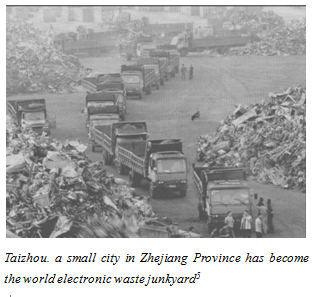
2.2 The country is getting old faster
China economy is very much labor intensive comparing with all western countries. One of the reasons of the fast economic growth for the last thirty years was the population bonus. However, the nation's sixth population survey showed the bonus is ending very fast. In 2010, there are 177 million people elder than 60. In 2015, this number will be increased to 200 million. Not only the elders are getting more and more, but also the burden on the young blood is getting heavier as the proportion of the people aged below 16 is getting smaller. In 2000, 9.1 workers support one 65 years elder. In 2030, this number will dramatically reduce to 3.7! All in all, China has passed its Lewis turning point. It comes so fast that even the government would decide to adjust the single child policy this year, China cannot avoid the big impact in next twenty years. When you walk on the street in cities along the east China coast, you can see the big help wanted ads at about every corner. The impact may not be a big deal for those companies with high return and fast growth, but it is a big deal for the millions of the China manufacturers that are struggling at the breakeven point of profit and loss.
Workers are working on export cloth
Manufacturer posts huge wanted for help ad along street in Taizhou this year.
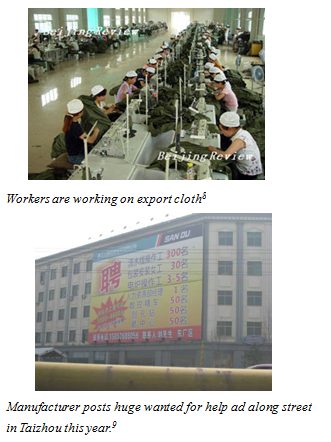
3 Common Symptoms of China Manufacturers
3.1 All troubled manufacturers are similar
The Russian writer Leo Tolstoy said:"All happy families are like one another; each unhappy family is unhappy in its own way." Working for more than a dozen companies and with about hundreds for near thirty years, I found all the situation with business is just the opposite: all the troubled companies are like one another; each successful company is successful in its own way.
Here are some examples apply this "Shaw's law". McDonald's success is from its standardization; Coke Cola's success is from its formula and culture; Dell's success is from its customized product production and fast capital turns; Toyota's success is from its TPS, etc. However, all the troubled China manufacturers are all have some or all of the following symptoms: lack of brand reorganization and proprietary intellectual property right; sales size may be big but net profit is very low; short in cash; high A/R; slow inventory turns; the companies are owner dominating, employees are not empowered and the company culture is very negative. If we use the evaluation matrix that some western company used over strategy, marketing, process standardization, supplier management, employee involvement, workplace, etc., and scored from 0-5 (0 is the lowest and 5 is the highest), most China manufacturers are averaged at 1 place, verse about 3 with those in the USA and 5 with Toyota before 2007.
3.2 The economics explanation
Influenced by the government at all levels focuses too much on the GDP driven, the enterprises also focus too much on sales scales. Besides the Chinese cares more about face more than any people in the world, owners or managers of the companies think if the sales is increased, the fixed cost will be driven lower proportionally. The company will then be more profitable.
The logic is correct accounting wise from the standpoint of view of each individual manufacturer. However, in a free market, the demand and supply curves can explain what happened before and after the turning point if no differentiated product is introduced to the market. So, after the similar effort made by all manufacturers, the market price will drop further. Then the manufacturers will suffer more from low profit. In this way, the low value added country's economic mode will keep swirling down.
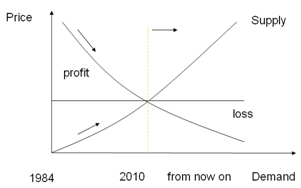
4 High ROE Lean Businesses is the only way to go
Discouraged by the government policies that favor more to real state and finance, more and more entrepreneurs switch their focus and investment to other places. That is very bad for the country at long runs. That is also a choice of defeat for the entrepreneurs as the manufacture enthusiasts who are the precious assets of this country.
Americans have been relocating their manufacturing to the eastern country and Mexico for the last thirty years. Japanese developed TPS more than 40 years ago. Both countries and their manufacturers have been kept moving upward in the global value chains. Now, it is the time for China to start to do more of the same thing.
From the inside manufacturer standpoint of view, after visiting dozens "Made in China" factories who private label all type of foreign brands along the east coast of China lately, I often heard the people in those businesses complaint that "we have more than a thousand motor/electrical tools/electric cars/fans/water pumps… companies in the country, all struggle for the thinner and thinner profit." With the negative trend above mentioned, remembering what happened with the similar situation in American manufacturing history last century, it should not be surprised if we see half of the companies compete at the homogenous level may be out of business in the next 5 - 10 years!
Studying the business cases from America, Japan, Taiwan and my own practice in the past 20 years with many companies, the business model in chart below may represent what China manufacturers need to practice more . It is called differently by different people as Smiling Curve, Dummy Bell model, DPATS model, etc. I call it the "high return lean business". It is a systematic engineering among Division of Labor Theory, Value Mapping Theory, Investment Theory, the Core Competence of the Corporation Theory, etc.
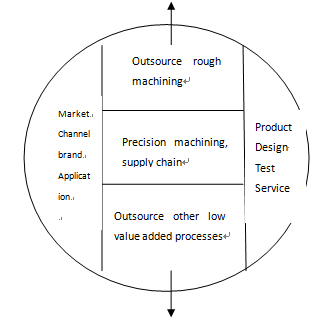
5 Transformation is not easy and many may not make it if consciousness is absent
Question may be raised: if everyone does that model, who would actually work on the lower value added work?
That should not be a worry. In fact, the worry is on the other direction with many businesses. Many entrepreneurs actually choose either refuse making a lean change, or to start another business that belong to different industry, but is still at the same low value added homogeneous level at that different market. For instance, an entrepreneur who made his "first barrel of gold" from private label electronic hand tools for an American company invests another manufacturer that private label non-stick pan for a European customer.
Why? It is about the human nature, especially the human nature with many of the first generation of successful China entrepreneurs. It is a common human tendency to credit success to self while blame failure to others. Not trying to underestimate their success comparing with other people at the same time, what credit they take more than reality in their mind without awareness? The initial conditions that made them more successful than they could possibly made in a more mature market place: 1) China economic reformation started from the stage with extreme shortage of everything. Anything an entrepreneur could sell was wanted badly by the market at the time; 2) lack of competition thirty and twenty years ago that made the business successful easier than today; 3) the cost of everything was significantly lower at the time when China was among the lowest income countries in the world; 4) the customers by then were very less sophisticated than those of today; 5) the regulation and rules were less and lose in the past; 6) the greatest change of the county in the past thirty years .
Beyond the above mentioned 6 favorable factors, the next fact may multiplied the over self-confident level even more. Because of the historic reason, most of China entrepreneurs do not have high level education, let alone an EMBA degree. So, if they are not a gifted autodidact, their self consciousness can be well behind their business success by dollar sales scale today. Therefore, the entrepreneurs can easily get lost in today's business inter-sections; although they are reluctant admit this publically.
6 Worries and hope
Interviewed with dozens entrepreneurs in months, the impression was that about a half of the entrepreneurs are belong to those "at loss" or "over confidence without conscious awareness" categories, although most of them do have pressure from the competition and nation's transformation. These entrepreneurs are the reason why their businesses are there. No one can deny their success. However, ironically, their blind mind set is also the very block against their own businesses to be successfully.
transformed in the next 10 years. In other word, about a half of the manufacturers led by them may be out of businesses in the next 10 years during the transformation period of time of the market, the industry and the whole country!
Fortunately, there are also a lot of modest entrepreneurs who have the traditional Chinese virtual and wisdom. They acknowledge and credit the most to the country, the time and the people who worked for them. They do not try to pretend knowing and being capable of doing everything. They are humbly looking for new awareness and good help for their businesses' transformation. They are the hope of their own enterprises and the manufacturing of the country.
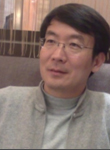 About Professor Raymond Shaw Ph.D., the author:
About Professor Raymond Shaw Ph.D., the author:
• An American Chinese Entrepreneur worked for many famous American multinational companies at senior position like President, Operations VP, Chief Engineer, Lean Production Director, Marketing/Sales Director, etc. in more than twenty years both in the USA and in China. He is very experienced in establish companies, manufacturers, JVs, M&A, business reengineering and transformation.
• He is a Mentor of MBA, Euromed Management, Research Fellow (professor) of Industrial Engineer Department and Lean Production Research Center in Beijing University, Professor of Mechanical Engineering in Donghua University and Henan Science and Technology University.
• He won the "Magnolia Award" in 2006 from the Shanghai Government as an outstanding contributor to Shanghai
Research from IHS Global Insight first reported on by the Finance Times , March 13, 2011
Sun Ming Chun: Challenge in 2020 for China. China Business News May 17, 2011
China Daily report: Oct. 21, 2003
Keith Schneider: Choke Point: China—Confronting Water Scarcity and Energy Demand in the World's Largest Country. Circle of Blue
Global Times May 10, 2011
China Business News: Now is the best window to adjust the birth control policy by Ding Xiaoqin. May 16, 2011
China Business News: China has passed its Lewis Point (Gao Shancun). April 16, 2011
Singapore: Joint Morning Newspaper
Raymond Shaw: The goal for lean enterprise is for high return. China Equipment May 2011.
Same as note 9
Same as note 9
Meng Xianzhong: Corporate Strategy Management. May 2011. China CEO Innovation Management Program in Antai College of Economics and Management. Shanghai Jiao Tong University
上海伊莱茨真空技术有限公司 版权所有 严禁复制
地址:上海市青浦区胜利路1680号1期4号楼1单元101 电话:+86-21-6921 3682;+86-21-6921 3683
网站备案号:沪ICP备16022165号-1 沪公网安备 31011802002277号 建站公司:铭心科技





